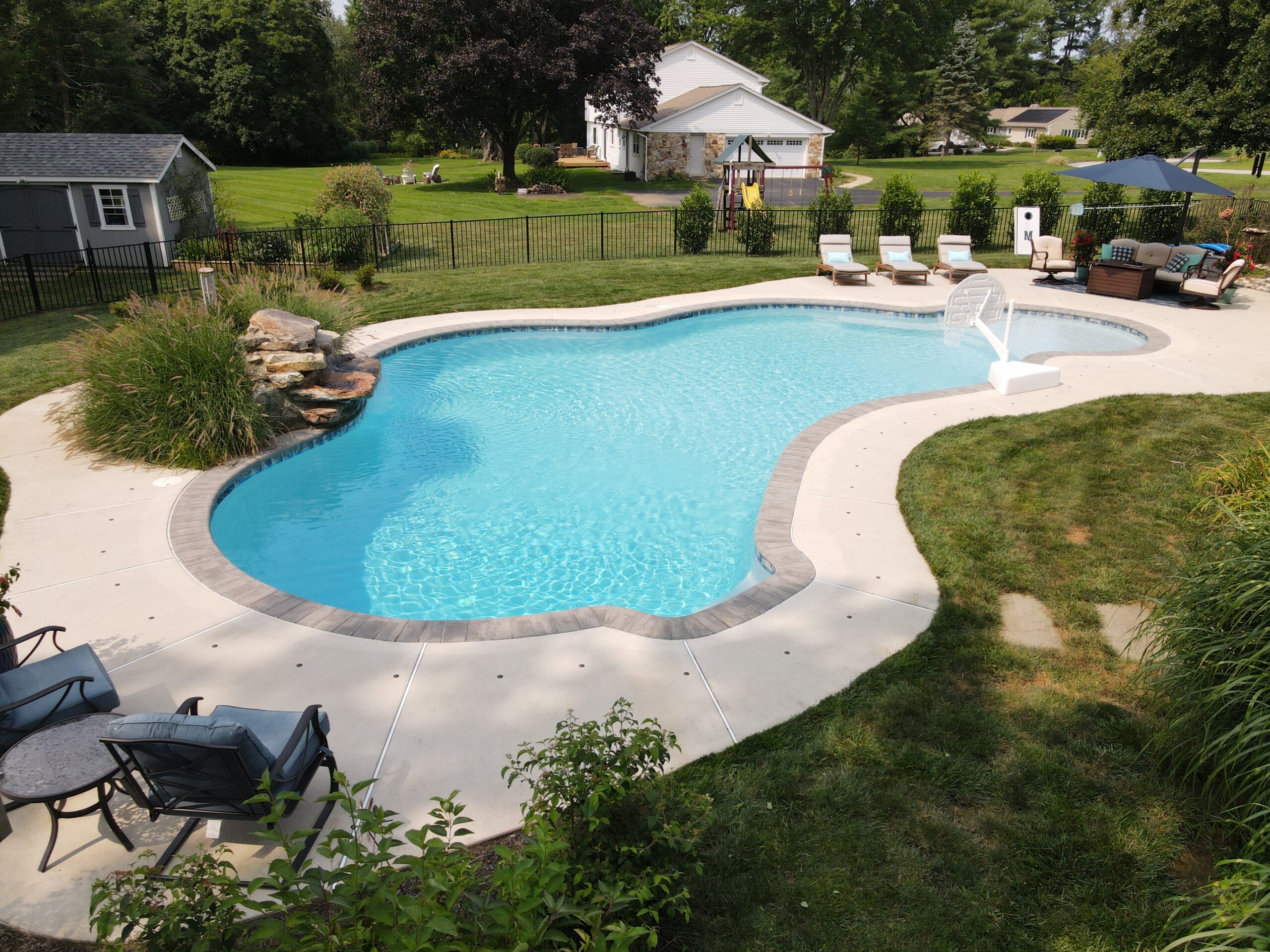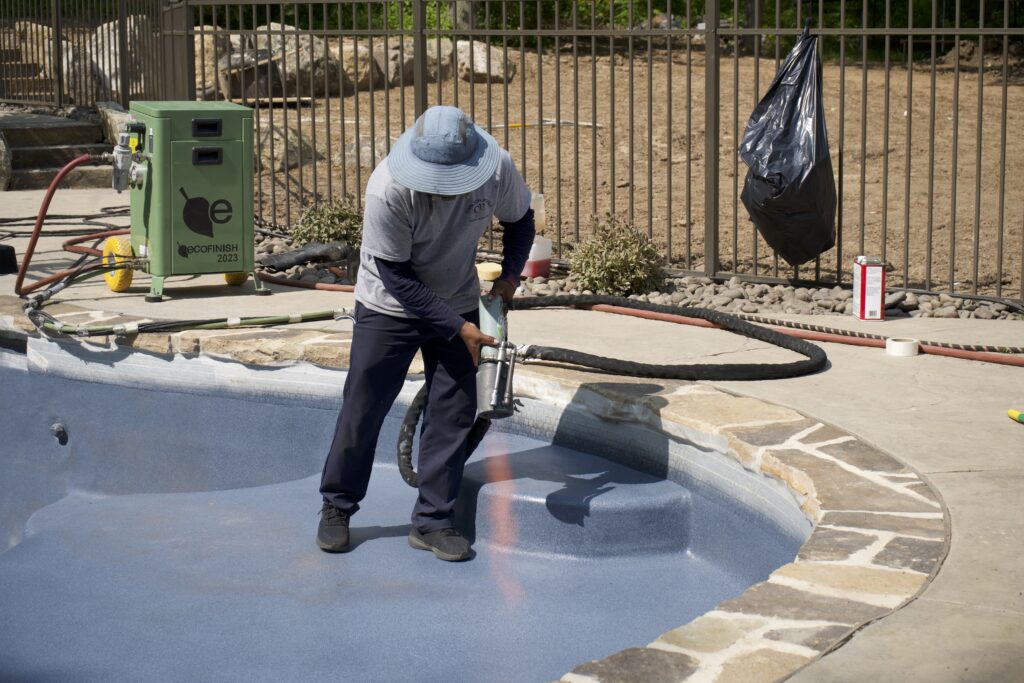
Many pool owners are trying to cut down on chlorine use in their swimming pools. Here’s some sustainable solutions for this common problem. These methods not only reduce chlorine levels but also improve water clarity and protect pool surfaces.
Reducing Chlorine Levels in a Swimming Pool
Reduce chlorine levels in a swimming pool by using various methods. These include diluting pool water, removing the pool cover, applying chemical agents like sodium thiosulfate, using a mineral system or salt water system, utilizing an ecoFINISH coating, and using AquaSpada for biofilm removal and scale prevention.
Diluting pool water
Diluting pool water effectively reduces chlorine concentration and improves overall pool water quality. Adding fresh water to the swimming pool dilutes the chemicals, including chlorine, cyanuric acid, and other contaminants.
This process helps in maintaining balanced levels of chemicals in the pool, ensuring a safer swimming environment. For pools with high chemical concentrations or after heavy usage, dilution serves as an efficient technique for restoring optimal water chemistry.
Removing pool cover
When removing the pool cover, it allows sunlight to penetrate the water, which can help reduce chlorine usage. Sunlight exposure assists in breaking down organic matter and chloramines, leading to a decreased demand for chlorine in the pool water.
This natural process aids in maintaining balanced chlorine levels and reduces the reliance on traditional chemical-based treatments while promoting an environmentally friendly approach to swimming pool maintenance.
Additionally, uncovering the pool facilitates better air circulation, preventing the build-up of harmful contaminants that would require higher chlorine levels for sanitation. A well-maintained uncovered pool also inhibits algae growth, reducing the need for excessive chemical treatment.
Using chemical agents like sodium thiosulfate
Chemical agents like sodium thiosulfate are commonly used to reduce chlorine levels in swimming pools. When added to pool water, sodium thiosulfate neutralizes chlorine, making it less harsh on swimmers’ skin and eyes.
Sodium thiosulfate is an essential component in reducing free chlorine levels and maintaining a healthy chemical balance. It allows for safer and more comfortable swimming experiences without compromising on sanitization or purification standards.
Using a mineral system or salt water system
A mineral system or salt water system provides an eco-friendly alternative for pool water treatment. With a salt water system, the pool owner can generate chlorine from the salt in the water, reducing the need for additional chemicals.
This not only minimizes environmental impact but also provides a sustainable solution for pool maintenance. Similarly, a mineral system utilizes natural minerals to purify and clarify pool water, significantly decreasing reliance on traditional chlorine-based products and fostering cleaner, environmentally safe pools without compromising sanitation.
Applying ecoFINISH coating
Transitioning from using a mineral system or salt water system, applying an ecoFINISH coating offers a sustainable and effective solution for pool maintenance. An aquaBRIGHT coating does not disrupt the water’s chemical balance, resulting in substantially fewer chemicals being used compared to other pool coatings.
By choosing ecoFINISH, pool owners can achieve water clarification, protect pool equipment, and ensure scale and biofilm removal. This environmentally safe aquatic finish provides an alternative that supports nontoxic pool maintenance while promoting sustainable pool solutions.

Using AquaSpada for biofilm removal and scale prevention
AquaSpada is a biofilm removal and scale prevention solution that significantly reduces the need for chlorine in swimming pools. By utilizing AquaSpada, pool owners can decrease their chemical usage by almost fifty percent, leading to substantial reductions in both cost and environmental impact.
This product effectively kills 99% of contaminants passing through it, resulting in a significant reduction in the amount of chlorine required for pool maintenance. Additionally, ecoFINISH coatings complement AquaSpada by offering a surface that does not alter the water’s chemical balance, contributing to substantially fewer chemicals being used compared to other pool coatings.

Conclusion
Reduce chlorine levels in your swimming pool with ecoFINISH and AquaSpada. Eliminate excessive chemicals and contaminants by using these innovative products. With ecoFINISH, maintain a balanced pool without altering the water’s chemical balance.
The combination of AquaSpada and ecoFINISH provides an effective, sustainable solution for environmentally friendly pool maintenance. Enjoy a cleaner, healthier pool while minimizing the environmental impact of excessive chlorine usage.
FAQs
An ecoFINISH coating is a type of environmentally safe pool treatment that covers your pool surface, making it smoother. This helps to prevent algae growth, reducing the need for high levels of chlorine to keep the water clean.
Yes, AquaSpada works as an alternative pool sanitization method by purifying the water naturally. It reduces the reliance on chemicals like chlorine for keeping your swimming pool water clean.
ecoFINISH creates a protective barrier that prevents damage from harsh chemicals, while AquaSpada’s purification process extends the life of your pool equipment by maintaining cleaner water without heavy chemical use.
